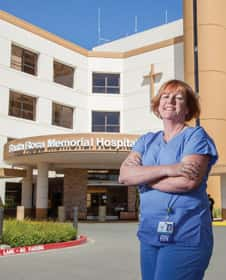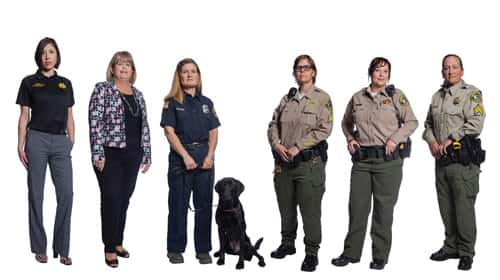
Misti Harris, Heidi Keith, Caroline Upton, Liana Whisler, Jessica Silva, Mechelle Buchignani
Trying times have a way of bringing out the best in people, and the North Bay’s women more than showed their mettle when wildfires tore through parts of Napa and Sonoma counties in October 2017, creating a firestorm that fouled the air, destroyed more than 5,000 homes and took 46 lives. Female first responders and workers behind the scenes provided critical support, as they responded to a sudden, rapidly growing disaster of a magnitude no one could have predicted. And although their humility prevents them from admitting it, their stories are extraordinary.
Up close
Firefighter Caroline Upton is a volunteer with the Mountain Volunteer Fire Department, located in the hills off Petrified Forest Road. On October 8, she and her husband, Anthony, also a Mountain firefighter, stepped outside their home to respond to a smoke investigation call from their dispatcher when they realized there was a fire starting just north of their home. By the time, Caroline hung up with dispatch, the fire had already crossed Highway 128, and was burning the ridge north of them. Two homes were already engulfed in flames. She called her fire chief to inform him they would be delayed in responding to the call since they had to evacuate. She and Anthony alerted their neighbors, and then evacuated in their SUV with their two children, dog and cat. “I didn’t connect the dots,” she says, but what she had seen was the beginning of the Tubbs fire.
Once her family was safe, Upton reported for work. She handled medical calls, which included burn patients and a couple suffering from hypothermia after jumping into their swimming pool to escape the flames. Later, she and her crew were sent to do an entrapment rescue 30 minutes away, but by the time they arrived, the fire had moved so quickly and fast, there was nothing that could be done except to evacuate. “We were on the initial attack,” she says, and with walls of fire all around, she realized how severe the situation was. Rescue calls continued to pour in, and she worked with a Cal Fire crew to care for numerous burn patients. “For us as first responders, we were going as fast and safely as we could,” she recalls. “It was crazy. It was so fast-moving and hectic.” Once the immediate danger had passed, she worked on mop-up and extinguishing hot spots along with her crew.
As a volunteer for Team Rubicon and Relief International, Upton has traveled around the world helping people after disasters. She has traveled to such places as Sri Lanka following the tsunami in 2004, to New Orleans during Hurricane Katrina in 2005 and Houston after Hurricane Harvey in 2017. She was also slated to go to Puerto Rico in the fall after Hurricane Maria, but stayed to help at home instead. This time, though, she had to deal with a disaster in progress. “There wasn’t a lot we could do, because the fire just roared through,” she says.
Once conditions were safe, she helped people deal with the aftermath, directing them to resources to meet their immediate needs, escorting them to what was left of their properties and helping them sift through the rubble. “It was hard work, but important work, which I’m super passionate about. I’m continually amazed at people’s fortitude in such a tragic situation,” she says. “I love my community, and I loved being able to give back in that way.”
Smoke and fire
Sheriff’s Deputy Jessica Silva received a Nixle alert early on Monday, Oct. 9, and then her neighbor pounded on her door shouting that Santa Rosa was on fire. She looked out at the glowing sky. “It was disbelief for me. I couldn’t understand what was burning so brightly,” she recalls. Sensing she’d be needed, she got her uniform ready, left her family at their Bennett Valley home and headed into work. On the road at 5:30 a.m., she realized the situation was dire. “Everything was black from smoke. I knew it was supposed to be daylight. It was an eerie feeling,” she says.
Silva works in personnel, doing background investigations on people who apply to work for the Sonoma County Sheriff’s Office, but she went straight to the briefing room rather than her office. “Even deputies who had lost their homes were dressed and ready to go. That was tough,” she says. They were assigned to go on patrol in pairs, and Silva and her partner went to Larkfield and Mark West, answering calls for service and checking to make sure people were safe. Most people had left, and houses were piles of ash with the occasional framework of a burned-out car remaining. Sometimes they went to an address where everything was gone, and all they could do was hope the occupants had escaped. Meanwhile, the fire was still burning; the air was thick with smoke; and they could hear the crackling of trees on fire. They had to avoid downed tree limbs and power lines, and several times, they were out of the car and had to run to safety to avoid being hit by falling telephone poles. Once it was safe, Silva escorted people to what was left of their homes. Watching them sift through the ash to find anything they could was heartbreaking. “One lady found a little ceramic figure her father had given her when she was 12. It was very emotional,” she says.
“The hardest thing was that this was so personal,” she says because friends and coworkers had lost their homes, and it was chilling. “The experience was so humbling. I don’t think any of us will be the same. … I dealt with it by being there for people,” she says, giving hugs and sharing tears. It also helped to know that her husband (also in law enforcement) was safe, and their two boys and bearded dragon were out of harms way and safe with her parents.
Multitasking
Although the Nuns fire in Sonoma Valley broke out on Sunday, Oct. 8, it took until Friday to reach the City of Sonoma. “There was absolutely a threat, but it came later,” says Sgt. Mechelle Buchignani, who is assigned to the Sonoma Police Department by the Sonoma County Sheriff’s Office, which has a contract to provide the city’s law enforcement services. Buchignani, who lives in Santa Rosa, learned about the fires early Monday, when she received phone calls and texts. She made sure her family was safe and then headed into work, traveling through Petaluma instead of her usual route along Highway 12, thus avoiding the fire.
Her work usually is primarily a supervisory role, but the firestorm brought new demands, which mostly involved actively assisting with evacuations. Because they had a little lead-time, Buchignani and her fellow officers could anticipate some of the challenges and did a mid-week advisory evacuation, directing drivers to take specific routes. As the fire got closer, a mandatory evacuation order went into effect. “The fire never hit the eastern side of the city, but did cause damage just outside city lines, and to the east,” says Buchignani. “The firefighters had a plan to use the Plaza as a fighting line, but that plan never came to be, as the fire moved away from the city and to the east,” she says.
“We were doing evacuations in that time frame,” says Buchignani. Rest homes and hospitals needed special equipment, such as buses that could handle wheelchairs, and she found them and got them to Sonoma. At the same time, she made a call to the Sonoma/Valley Emergency Operation Center (EOC) for supplies and was out in the field working with deputies and officers to help maintain order, while they kept looters away from unoccupied homes. She also took shifts supervising the EOC, alternating with Chief of Police Brett Sackett and Sgt. Jason Craver. Among her tasks, she gave officers their assignments and made sure they were in the correct place with everything they needed. It was difficult task since she was sending them into perilous situations and worried about them. ”You’re sending your guys out, and you’re not with them,” she says. But, she adds, “This is just what we do. … You’re working with a bunch of people who have a warrior’s spirit, but a servant’s heart.”
Keeping calm
When Sgt. Liana Whisler, inmate services coordinator at the Sonoma County Sheriff’s Office Main Adult Detention Facility, smelled smoke late Sunday evening, she thought it was a barbecue. On the drive in to work, she couldn’t get a radio station, however, and suspected something was wrong. Her shift started at 3 a.m., but she headed to work early and found chaos on the roads. The sky was orange at Highway 12, a car was engulfed in flames near Coddingtown, and the fire had crossed the freeway in north Santa Rosa, so drivers were doing U-turns on Highway 101. She called home to inform her family and sped up. When she arrived at work at 2:30 a.m., she saw one of her co-workers, Sgt. Eric Saya, with his wife and dog, and learned that fire had driven them from their Fountaingrove home.
“I knew there was a major disaster,” says Whisler. Her training took over as she focused on making sure the people she was responsible for were safe. She was briefed by her partner, Sgt. Dominic Taurian, and together they divided the responsibilities and got to work. Sgt. Whisler began working with staff on duty, assigned tasks and addressed issues as they occurred. The power was out, and they couldn’t make the usual breakfast for the inmates, so she sent four inmates who usually work in the kitchen, to make sandwiches and bag lunches, while a deputy and one kitchen staff member stood by. Her staff was scared, and she made sure they were busy, pairing them up so they’d have partners to handle problems. Some knew they had lost their homes and were sobbing, and she knew it was her responsibility to help keep them calm and focused.
The detention center’s exterior cameras showed flames beyond Kaiser Permanente Medical Center. At one point, Whisler knew their situation was getting worse. “The building had quite a bit of smoke, and I knew the fire was very close,” she says. Whisler was honest with the inmates and told them Santa Rosa was burning when they woke up and asked what was happening. “We took every measure we could to keep the smoke at a minimum,” she says, including having a deputy turn the HVAC system off and one and calling in a maintenance worker to monitor the HVAC system.
In retrospect, Whisler feels good about her work during an extremely challenging time and is proud of her coworkers. “The staff was amazing that day,” she says, crediting them with doing an excellent job with the inmate population. “I saw the best in the people I work with and the people I work for.”
Spreading the word
Misti Harris, community engagement liaison for the Sonoma County Sheriff’s Office, woke up at 1:30 a.m. on Monday, when her mobile phone dinged with a Nixle alert. She could feel hot, smoky air. “Something in my gut told me something was really, really wrong,” she recalls. Half an hour later, she received a call from a lieutenant, who told her she was needed and calmly advised her to take Guerneville Road from her home in Forestville, rather than Highway 101. When she started out, she saw a faint orange glow, and it grew brighter and brighter as she approached Santa Rosa. It felt surreal and reminded her of Dante’s Peak, a 1997 disaster film about people fighting to survive after a volcano erupts.
When she arrived at the main office on Ventura Avenue, she had difficulty seeing. At first, she thought her contact lenses were dirty, but the smoke was obscuring her vision. She reported to the EOC along with public information officers from throughout the county and found the phones ringing off the hook. She began answering reporters’ questions, sending out evacuation notices using Nixle and distributing pertinent information to the public. She needed to share maps and shelter locations and report the number of missing people and fatalities, but the power and Internet were out for many Sonoma County residents. “Sometimes are cell phones worked and sometimes they didn’t,” she says. In addition, the Sonoma County Fairgrounds, where the press conferences were located, didn’t have reliable cell service for live streaming, so she captured what she needed on video and returned to the office to post it on Facebook.
Constantly changing information in a massive event created a heavy workload. “Two days into it, we realized we needed more help,” says Harris. As a result, a nighttime Public Information Officer was brought in to keep providing information around the clock. Harris was part of a team of five, including Sheriff Robert Giordano, who gave out information from talking points she provided at regular press conferences. She continually updated the Facebook page as well, providing a way for residents and news outlets to keep up to date, but first she had to check facts to make sure the reports she received were correct. In addition, their communication efforts involved relaying information in two languages. “We brought in a translator to get out the information in Spanish on our Facebook page,” she says.
Despite the challenges, the work brought a measure of satisfaction. “It was an honor to work with everybody here at the Sheriff’s Office,” she says. “I’ve never been so proud to work for an organization in my life.”
Behind the scenes
Heidi Keith, administrator services director for the Sonoma County Sheriff’s Office, learned about the Tubbs fire at 1 a.m. on Monday, when family members who were evacuated needed to take shelter at her Montgomery Village home. She waited to go into work until she knew her services were required, and Sheriff Giordano called at 3 a.m. “The moment he called, I knew it was serious, very serious,” she recalls.
Keith oversees business for the Sheriff’s Office, keeping everything running smoothly, supporting everything from activities in the field to the operation of facilities. Normally, that would involve duties such as budgets and payroll. In the emergency response framework, though, she was in charge of logistics, which made her the procurer and supplier. At 4:35 a.m., she met with everyone to get a feel for the requirements and determined that acquiring food was a priority. “I got in my car and found the first grocery store that was open,” she says.
She worked alone at first, but quickly put together a team to begin assessing the needs and predict what they would need short and long-term. Food was major, because they eventually had to provide food for 500 people in local law enforcement, mutual aid from more than 100 agencies in other counties and close to 150 members of the National Guard. “Most of the food was deployed out of this office,” says Keith. What’s more, much of it had to be portable so people going out into the field could take it with them. Sheriff’s Office employees did some of the food preparation. “I had accountants making peanut butter and jelly sandwiches,” she recalls.
Some needs, including portable toilets, were basic, while others were specific, such as rubber gloves and boots for search and rescue teams and spray paint to show which areas they had searched. The National Guard needed a special battery, which her team tracked down, and dispatch needed air purifiers. And without being asked, Keith and her team recognized small needs, such as drops for irritated eyes and balm for parched lips. “Some of it was just being human about it,” she explains. She and her team acquired most of the items from local stores, including Target and Costco, which opened early for them several times.
Keith praises her team. “I was so impressed by everyone at this office,” she says. “The professionalism and the willingness to do anything that needed to be done was incredible to me,” she says. “Females contributed and played such a large part.”
Professionalism, dedication to family and compassion were all part of the women’s response, and love of community was a factor as well. Caroline Upton believes that it’s empowering for strong women, when they find ways to connect with their communities. “It’s a great thing,” she observes. “I’m merely a spoke in a wheel of amazing people.” And it’s a wheel we’re all fortunate to have.
The power of facebook
Misti Harris found that Facebook was one of the most effective ways to disseminate information during the wildfires, and she and her team constantly updated the Sonoma County Sheriff’s Office Facebook page (@sonoma.sheriff) Before the emergency, it had 36,000 followers, and it increased to 72,000 as the disaster unfolded. In addition, 80,000 viewers watched videos on live stream. “We put everything out on Facebook. Our page is a reliable source of information,” she reports.
all hands in: Responding to a community in crisis
 Registered nurse Lorna Kennedy-Klein and her husband, Ron, woke to a power outage, smoke and an ominous glow from the hills behind their home, when the Tubbs fire struck Santa Rosa. They found out the extent of the threat from reliable sources, gathered their rambunctious dogs and some essentials, checked on their neighbors to make sure they were leaving and headed to their jobs. Kennedy-Klein, a nursing manager overseeing several departments at Queen of the Valley Hospital, discovered that getting to Napa was impossible. Recognizing an urgent need at Santa Rosa Memorial Hospital, she took the initiative to volunteer her services there instead.
Registered nurse Lorna Kennedy-Klein and her husband, Ron, woke to a power outage, smoke and an ominous glow from the hills behind their home, when the Tubbs fire struck Santa Rosa. They found out the extent of the threat from reliable sources, gathered their rambunctious dogs and some essentials, checked on their neighbors to make sure they were leaving and headed to their jobs. Kennedy-Klein, a nursing manager overseeing several departments at Queen of the Valley Hospital, discovered that getting to Napa was impossible. Recognizing an urgent need at Santa Rosa Memorial Hospital, she took the initiative to volunteer her services there instead.
The first night, she was assigned to the emergency department to lend a clinical hand, and for the following 10 days, she worked in the command center as a member of the Incident Command Team. It was challenging because she had to quickly get used to new surroundings and didn’t know the workflow. However, the staff at Memorial helped guide the way. “The team here was incredibly supportive and gracious.”
One of the first people she met encountered that night was Todd Salnas, who greeted her on the parking lot and thanked her for responding to the disaster. Though she didn’t know it at the time, Salnas is the president of St. Joseph Health in Sonoma County. She met other members of the executive and leadership team as well. “All were kind, expressing concern for all of us whose homes were in jeopardy,” she says, even though many of them, along with physicians and staff, had already lost their homes. “I am humbled by the leadership and staff at this hospital,” she says, adding that she never heard a complaint and only saw simple, genuine caring for others.
Santa Rosa Memorial later offered her a position, which she accepted. “The opportunity to rejoin the emergency department at Memorial was exactly what I needed,” she says.
be prepared
 Misti Harris of the Sonoma County Sheriff’s Office urges people to be proactive, so they’ll know how to get information and be prepared when a disaster strikes. Here are a number of useful tips:
Misti Harris of the Sonoma County Sheriff’s Office urges people to be proactive, so they’ll know how to get information and be prepared when a disaster strikes. Here are a number of useful tips:
• Sign up for Nixle alerts. In Sonoma County, you can get alerts from the Sheriff’s Office and the Santa Rosa Police Department by texting your zip code to 888777 or going to local.nixle.com/register.
• Sign up for emergency alerts. Go to the Sonoma County Emergency Services Department emergency notification system at SoCoAlert.com.
• Identify sources of reliable information. Best to do this before an emergency situation, so you know where to get accurate reports.
• Have a working radio. During a crisis, radio is almost always available. “KSRO did an extraordinary job,” says Harris. Remember to keep extra batteries, or use a hand-powered radio.
• Use Facebook. The Sheriff’s Office puts everything on Facebook, and it’s a reliable source of information.
• Check on your neighbors in an emergency. This is especially important, if they’re older and vulnerable. For example, it’s difficult for hearing-impaired people to hear alerts, wind or sirens. “The importance of taking care of your neighbors can’t be understated,” says Harris.
• Make a neighborhood plan. A formal plan is ideal. “It’s important to think about it and take care of each other,” says Harris. “You never know what resources your neighbors have or don’t have.”
• Take a CERT class. Sign up for a Community Emergency Response Team class and learn how to take care of yourself, your family and your neighbors in a disaster. Local fire departments often offer CERT classes.
For those living outside Sonoma County, contact your local law enforcement and fire departments. Ask where to sign up for emergency alerts and where to find reliable information during a disaster.




